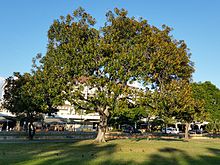| Ficus rubiginosa | |
|---|---|

| |
| Scientific classification | |
| Kingdom: | Plantae |
| Clade: | Tracheophytes |
| Clade: | Angiosperms |
| Clade: | Eudicots |
| Clade: | Rosids |
| Order: | Rosales |
| Family: | Moraceae |
| Genus: | Ficus |
| Species: | F. rubiginosa
|
| Binomial name | |
| Ficus rubiginosa | |

| |
| Range in Eastern Australia (in green) | |
| Synonyms[2] | |
|
List
| |
Ficus rubiginosa, the rusty fig or Port Jackson fig (damun in the Dharug language), is a species of flowering plant native to eastern Australia in the genus Ficus. Beginning as a seedling that grows on other plants (hemiepiphyte) or rocks (lithophyte), F. rubiginosa matures into a tree 30 m (100 ft) high and nearly as wide with a yellow-brown buttressed trunk. The leaves are oval and glossy green and measure from 4 to 19.3 cm (1+1⁄2–7+1⁄2 in) long and 1.25 to 13.2 cm (1⁄2–5+1⁄4 in) wide.
The fruits are small, round, and yellow, and can ripen and turn red at any time of year, peaking in spring and summer. Like all figs, the fruit is in the form of a syconium, an inverted inflorescence with the flowers lining an internal cavity. F. rubiginosa is exclusively pollinated by the fig wasp species Pleistodontes imperialis, which may comprise four cryptospecies. The syconia are also home to another fourteen species of wasp, some of which induce galls while others parasitise the pollinator wasps and at least two species of nematode. Many species of bird, including pigeons, parrots, and various passerines, eat the fruit. Ranging along the Australian east coast from Queensland to Bega in southern New South Wales (including the Port Jackson area, leading to its alternative name), F. rubiginosa grows in rainforest margins and rocky outcrops. It is used as a shade tree in parks and public spaces, and when potted is well-suited for use as an indoor plant or in bonsai.
- ^ IUCN SSC Global Tree Specialist Group & Botanic Gardens Conservation International (BGCI). (2021). "Port Jackson Fig Ficus rubiginosa". IUCN Red List of Threatened Species. 2021: e.T73089151A192225828. doi:10.2305/IUCN.UK.2021-1.RLTS.T73089151A192225828.en. Retrieved 24 March 2022.
- ^ "Ficus rubiginosa". Australian Plant Name Index (APNI), IBIS database. Centre for Plant Biodiversity Research, Australian Government.
